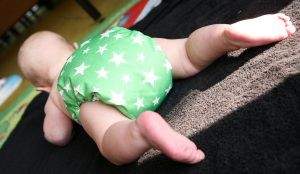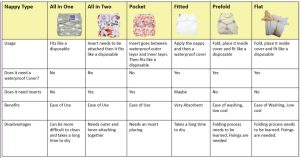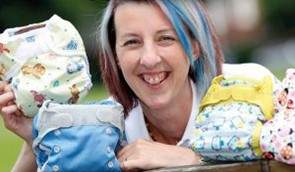Reuse Reusable Nappies

What are reusable nappies?
Reusable nappies come in a range of different styles and there are different options to suit different needs. They are essentially nappies that can we washed and reused which means that the need for disposable nappies is removed or reduced. Reduction in disposable nappy use creates less waste for disposal.
Using reusable nappies is a great choice for several reasons. From birth to completion of potty training, each child is likely to require at least 4,000 nappy changes*. The disposal of all those nappies could be prevented through the use of one set of reusable nappies, as they can see a child through that entire period. That same set of reusable nappies could then be handed down to a younger sibling or could be swapped/sold on for use by another child. Because of this, reusable nappies are normally cheaper in the long term than using disposable , and can be better for the environment too.
*= According to reusablenappyweek.org.uk/
Getting started with reusable nappies
To choose which type of reusable nappy may be best suited to a baby’s needs we have listed the main types below, listing some of the key information about each type. Predominantly, reusable nappies come in two sizes, new born and birth-to-potty (or one-size). Often, smaller babies that are below 10lbs may need a new born size until they grow to fit into one size nappies, however it is best to check this with the manufacturer.

The number of nappies you need will depend on the age of your baby, how often they may need changing and how often you intend to go between washes. It is estimated most people own between 15-25 reusable nappies.
If you are unsure whether reusable nappies are for you, you could try buying just one or two to see if they could work for you. You could also connect with a reusable nappy library to trial different types. It is also important to note that you do not have to exclusively use reusable nappies: even using them some of the time can greatly reduce waste.
Some other things you might want to be aware of when looking at reusable nappies are:
- Boosters – Nappy boosters are reusable pads that can be placed inside nappies to increase the absorbency of your nappies if needed. These may be useful for babies who are particularly wet.
- Disposable liners – To make laundry easier disposable liners are an optional extra, which can be used with most reusable nappies, they are placed inside nappies to catch solids which can then be placed in the bin (these should never be put in the toilet and flushed). This can alleviate concerns with solid wastes in the washing machine
- Promotional offers – Reusable nappy retailers often offer discounts, details of some schemes are available in our FAQ section.
- Pre-loved and seconds – Reusable nappies typically last longer than a single child needs to use them, so it’s possible to find useable pre-loved nappies at places such as Facebook marketplace, Olio, Gumtree and Freecycle (NB: eBay currently don’t allow the sale of pre-used reusable nappies). Some nappy libraries offer used loan kit nappies for purchase at a discounted rate, and some retailors offer seconds (slightly imperfect new nappies) at a discount via their websites
Guidance for switching to reusables
If you want guidance on how to use a reusable nappy, you can download our Reusable nappy user guide, this guide contains a variety of information on reusable nappy brands (however the list is not exhaustive and there are frequent changes to what is available on the market).
You can also watch our reusable nappy video demonstrations that show how to prepare, fit and use different types of reusable nappies.
For more information on all things reusable nappies please look at our frequently asked questions and care guide below;
We are looking for volunteer Reusable Nappy Advisors
Volunteer Reusable Nappy Advisors distribute free and impartial advice to residents interested in reusable nappies for their children.
No experience is necessary to become a volunteer Nappy Advisor as full training is available. It’s a great opportunity
 to join a scheme to benefit your community helping other people to save money and do something good for the environment.
to join a scheme to benefit your community helping other people to save money and do something good for the environment.
For more information visit our volunteering page or contact the waste team on:
Email: wasteprevention@leics.gov.uk
Tel: 0116 305 7005
The information provided here is covered by this disclaimer.
Also in Reuse Sub menu
Did you know?
From birth to completion of potty training, each child is likely to require at least 4,000 nappy changes












